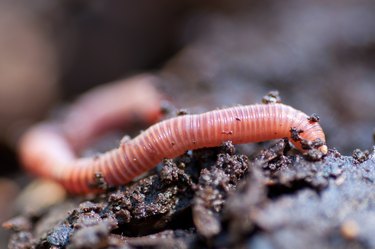
No one wants to walk outside and see worms on the concrete after rain. Let's face it – a walkway of slimy worms is fairly unpleasant. While you may wish to prevent earthworms from coming out of the earth, there's only so much you can and should do.
Why Do You See Worms on Concrete After Rain?
Video of the Day
According to conventional wisdom, earthworms come out of the ground when there is too much water in it for them to breathe. However, some researchers disagree with this theory because earthworms are able to breathe through their skin. Unlike humans and other creatures, earthworms do not have lungs that can fill up with water. It has been shown that they can survive underwater for weeks.
Video of the Day
Other experts believe that worms come out when it rains because they mistake the sound and activity for predators. Earthworm predators, such as moles, make vibrations in the soil as they move about. In the Appalachian Mountains, locals practice worm "grunting," where they use sticks to make vibrations on the soil. It is reported that this action brings the worms up to the top of the soil, where they are caught and used as bait. If you see earthworms on concrete after rain or tiny worms on your patio after rain, you can at least now understand the possible reasons for it.
Types of Earthworms
Worms are smooth-skinned and may be reddish-brown, pink, gray or white. Some have red blood that can be seen through their skin. They also produce slimy mucus to help them slide through soil and up onto walkways, patios, decks and driveways. They can range from less than 1 millimeter long to more than 2 meters in length.
There are four ecotypes of earthworms: anecic, endogeic, epigeic and compost. Anecic earthworms take leaves from soil surfaces and bring them down into vertical burrows that they make. Their heads are darker than their red or brown ends, they have pale tails and they are pretty large. Endogeic earthworms eat soil and make horizontal burrows, which can go down pretty deep. Their colors are green, blue, pale pink or gray.
Epigeic earthworms live on top of the soil, normally in leaf litter. They are not prone to burrowing into the soil and can be reddish-brown or bright red. As expected, compost earthworms like spending their time in compost piles or in places that have plenty of rotting vegetation. They are also known to reproduce quickly and are bright red with stripes.
Preventing Earthworms From Coming Out After Rain
While you might wish to eliminate earthworms, they are beneficial because they move nutrients around the soil, improve drainage and soil texture, break down organic matter and enrich and aerate soil. Having too many worms in one place can be a problem, though. To prevent this scenario, you can try using landscaping bricks, a shovel, garden fabric, a leaf sweeper and/or a rake.
Landscaping bricks can be used to edge sidewalks and patios, blocking off the earthworms' access. They add a nice decorative touch as well. Place them along all the edges, stacking them two or more high. This should reroute the worms elsewhere.
Alternatively, you can dig out 4 to 6 inches of soil and unroll some garden fabric on top. Return the soil to the hole, compacting it gently. A leaf sweeper can also be used to keep earthworms at bay. Use it all over the lawn to pick up extra worms after a rain or when it is humid. Raking up lawn clippings and loose leaves can also help; just make sure to dispose of this waste in a designated compost heap or trash bag.